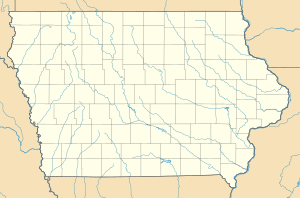
Eureka is a side-wheel paddle steamboat, built in 1890, which is now preserved at the San Francisco Maritime National Historical Park in San Francisco, California. Originally named Ukiah to commemorate the railway's recent extension into the City of Ukiah, the boat was built by the San Francisco and North Pacific Railroad Company at their Tiburon yard. Eureka has been designated a National Historic Landmark and was listed in the National Register of Historic Places on April 24, 1973.

Light Vessel Number 83 (LV-83) Swiftsure is a lightship and museum ship owned by Northwest Seaport in Seattle, Washington. Launched in 1904 at Camden, New Jersey and in active service until 1960 after serving on all five of the American west coast's lightship stations, it is the oldest surviving lightship in the United States, the only one still fitted with its original steam engine, and the last lightship with wooden decks. LV-83 was designated a National Historic Landmark in 1989, and has been undergoing major restoration since 2008.

The steamboat Ticonderoga is one of two remaining side-paddle-wheel passenger steamers with a vertical beam engine of the type that provided freight and passenger service on America's bays, lakes and rivers from the early 19th to the mid-20th centuries. Commissioned by the Champlain Transportation Company, Ticonderoga was built in 1906 at the Shelburne Shipyard in Shelburne, Vermont on Lake Champlain.

SS City of Milwaukee is a Great Lakes railroad car ferry that once plied Lake Michigan, often between Muskegon, Michigan and Milwaukee, Wisconsin. She was built in 1931 for the Grand Trunk Milwaukee Car Ferry Company and is the only pre-1940s ship of this type to survive. She now serves as a museum ship, bed and breakfast, and event venue on the waterfront of Manistee Lake in Manistee, Michigan. She was designated a National Historic Landmark in 1990.

Mayor Andrew Broaddus is a lifesaving station built by the United States Life-Saving Service located in Louisville, Kentucky, off the corner of River Road and Fourth Street. She is named in honor of Andrew Broaddus (1900-1972), a former mayor of Louisville (1953-1957). Her historic purpose was to protect travelers on the Ohio River from the Falls of the Ohio, with rescue crews for those who fell victim to the rapids. Louisville was the first place where a lifesaving station was placed in western waters. The first lifestation in Louisville was in 1881, with Mayor Andrew Broaddus as the third. A National Historic Landmark, she is the only surviving floating lifesaving station of the US Life-Saving Service.

Delta King is a 285-foot-long sternwheel steamboat (87 m) and the sister ship of Delta Queen, built in Scotland and California for the California Transportation Company's service between Sacramento and San Francisco, California. She entered service in 1927 and continued until 1940. After wartime service with the United States Navy, Delta King served as an accommodation ship at Kitimat, British Columbia in the 1950s and then returned to California for static use at Old Sacramento where she remains as a hotel, restaurant and venue.

George M. Verity is a historic towboat now displayed as a museum ship in Keokuk, Iowa. Built in 1927 as SS Thorpe, she is nationally significant for being one of only three surviving steam-powered towboats in existence in the United States. She was declared a National Historic Landmark in 1989.

Sergeant Floyd is a historic museum boat, serving as the Sergeant Floyd River Museum & Welcome Center at 1000 Larsen Park Road in Sioux City, Iowa. Built in 1932 as a utility vehicle and towboat, she is one of a small number of surviving vessels built specifically for the United States Army Corps of Engineers in its management of the nation's inland waterways. The boat has been restored and drydocked, and now houses exhibits about the Missouri River and local tourism information. The museum is a facility of the Sioux City Public Museum.
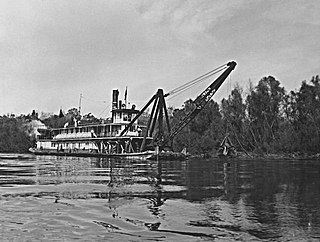
Montgomery is a steam-powered sternwheel-propelled snagboat built in 1925 by the Charleston Dry Dock and Machine Company of Charleston, South Carolina, and operated by the United States Army Corps of Engineers. Montgomery cleared snags and obstructions from the Coosa, Alabama, Apalachicola, Chattahoochee, Flint, Black Warrior, and Tombigbee Rivers until her retirement from the Corps of Engineers on November 8, 1982. She was restored in 1984 and again in 2004. One of only two surviving Army Corps of Engineers snagboats, she was declared a National Historic Landmark in 1989. Montgomery now operates as a museum ship at the Tom Bevill Lock and Dam Visitor Center in Pickensville, Alabama.

Wapama, also known as Tongass, was a vessel last located in Richmond, California. She was the last surviving example of some 225 wooden steam schooners that served the lumber trade and other coastal services along the Pacific Coast of the United States. She was managed by the National Park Service at San Francisco Maritime National Historical Park until dismantled in August 2013.

A snagboat is a river boat, resembling a barge with superstructure for crew accommodations, and deck-mounted cranes and hoists for removing snags and other obstructions from rivers and other shallow waterways.
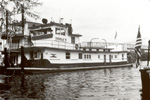
Standard, also known historically as Donald B and Barbara H, is a paddlewheel towboat that has been named a US National Historic Landmark and is now based at Bellaire in eastern Ohio. Built in 1923, she is the oldest surviving unaltered rear-wheel towboat afloat. The boat was declared a National Historic Landmark in 1989.

Grace Bailey, also known for many years as Mattie, is a two-masted schooner whose home port is Camden Harbor, Camden, Maine. Built in 1882 in Patchogue, New York, she is one of four surviving two-masted wooden-hulled schooners, once the most common vessel in the American coasting trade. She was one of the first ships in the fleet of historic vessels known as "Maine windjammers", which offer cruises in Penobscot Bay and the Maine coast, entering that service in 1939. She last underwent major restoration in 1989-90. She was declared a National Historic Landmark in 1992.

Luna is a historic tugboat normally berthed in Boston Harbor, Massachusetts. Luna was designed in 1930 by John G. Alden and built by M.M. Davis and Bethlehem Steel. She is listed on the National Register of Historic Places and is a U.S. National Historic Landmark. In 1985, the Luna was designated as a Boston Landmark by the Boston Landmarks Commission.

SS Ste. Claire is a steamer located in Detroit, Michigan. Built in 1910, she was one of the last propeller-driven excursion steamers to be operated on the Great Lakes. She was declared a US National Historic Landmark in 1992. In 2018, a devastating fire destroyed the upper decks, leaving only the steel structure.
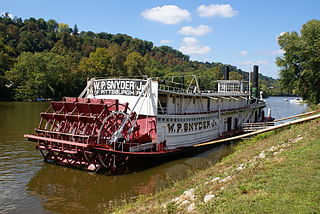
W. P. Snyder Jr., also known as W. H. Clingerman, W. P. Snyder Jr. State Memorial, or J. L. Perry, is a historic towboat moored on the Muskingum River in Marietta, Ohio, at the Ohio River Museum. A National Historic Landmark, she is the only intact, steam-driven sternwheel towboat still on the nation's river system.

Baltimore is a preserved steam-powered tugboat, built in 1906 by the Skinner Shipbuilding Company of Baltimore, Maryland. She is formerly the oldest operating steam tugboat in the United States, but at present does not hold an operating license issued by the US Coast Guard, so is unable to leave her dock at the Baltimore Museum of Industry on Key Highway, Baltimore. Her hull is not capable of operating on open water. Baltimore was built and operated as a harbor inspection tug, capable of acting as a municipal tugboat for city barges, as well as an official welcoming vessel and VIP launch, an auxiliary fireboat, and as a light icebreaker.
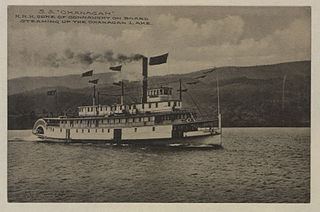
SS Okanagan was a steamship owned and operated by the Canadian Pacific Railway Lake and River Service. The vessel was constructed in 1906 at Okanagan Landing and launched in 1907, becoming Okanagan Lake's second steamship. She linked the transportation hubs at both the north and south ends of Okanagan Lake (Vernon and Penticton, respectively, aiding the development of interior British Columbia with other steamships of the 1900s. The ship was retired in 1934 and sold for scrap and spare parts. Only the Stern Saloon, a room in the back of the upper deck, remains. It was moved to the SS Sicamous Heritage Park in Penticton in 2002, to undergo restoration work.
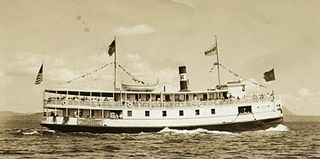
The Katahdin is a historic steamboat berthed on Moosehead Lake in Greenville, Maine. Built in 1914 at the Bath Iron Works, it at first served the tourist trade on the lake before being converted to a towboat hauling lumber. It was fully restored in the 1990s by the nonprofit Moosehead Maritime Museum, and is again giving tours on the lake. One of the very few surviving early lake boats in Maine, and the oldest vessel afloat built at Bath, it was listed on the National Register of Historic Places in 1978.

The SS Lakeland was an early steel-hulled Great Lakes freighter that sank on December 3, 1924, into 205 feet (62 m) of water on Lake Michigan near Sturgeon Bay, Door County, Wisconsin, United States, after she sprang a leak. On July 7, 2015, the wreck of the Lakeland was added to the National Register of Historic Places.

